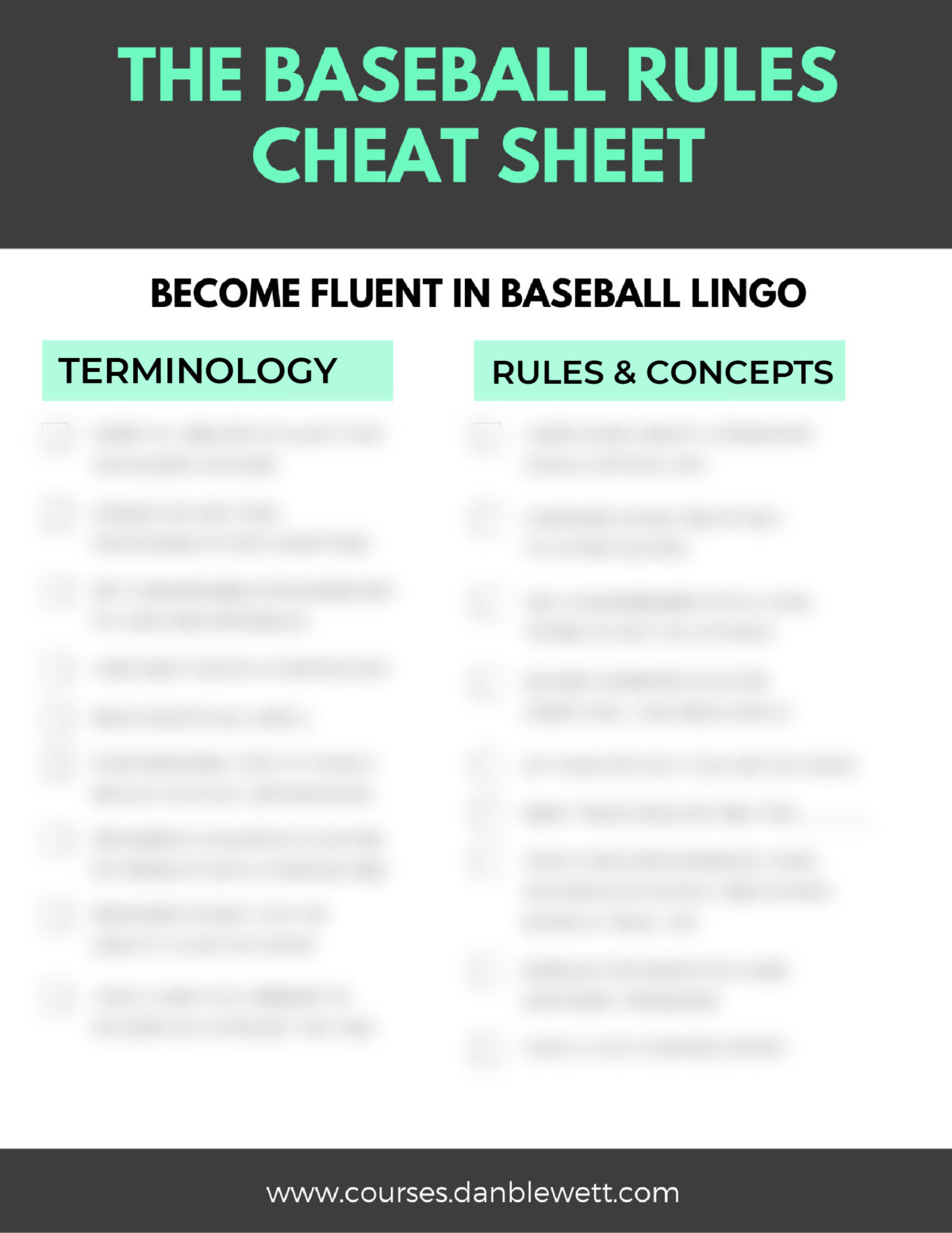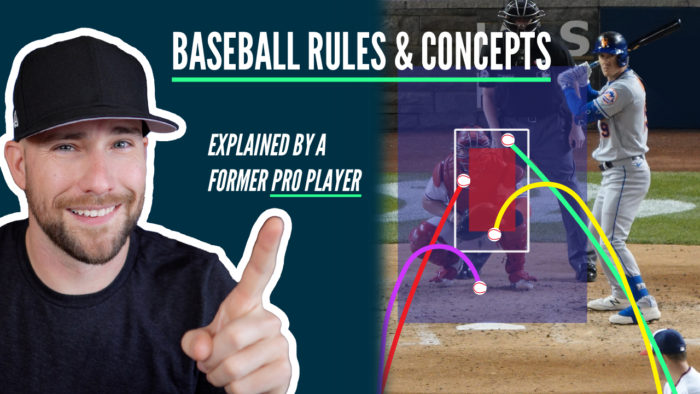*This article may contain product links which pay me a small commission if you make a purchase. Learn more.
In this article we’ll go over all the core rules of baseball – the foundational things you should know if you’re a beginner and want to understand the game. Check out the table of contents below to skip around to different rules and concepts. If you need to know the difference between article on baseball vs softball, I’ve got you covered there too.
Baseball Rules 101: The Fundamentals
If you prefer to watch a video on the rules (highly recommend) check out my video below in which I demonstrate the rules of baseball. I also have a detailed article on balk rules, which are hard to understand for beginners.
This video will walk you through the gameplay, rules of baseball, strategy, concepts, terminology and more.
The Baseball Field – Dimensions, Fair vs Foul & More
Let’s start with the baseball field itself. A regulation baseball field has dimensions of approximately 330ft down each foul line, with a distance to the center field wall of 400 feet. Bases are 90 feet apart and the pitching rubber stands 60 feet 6 inches away.

A baseball field is broken up into an infield and an outfield.
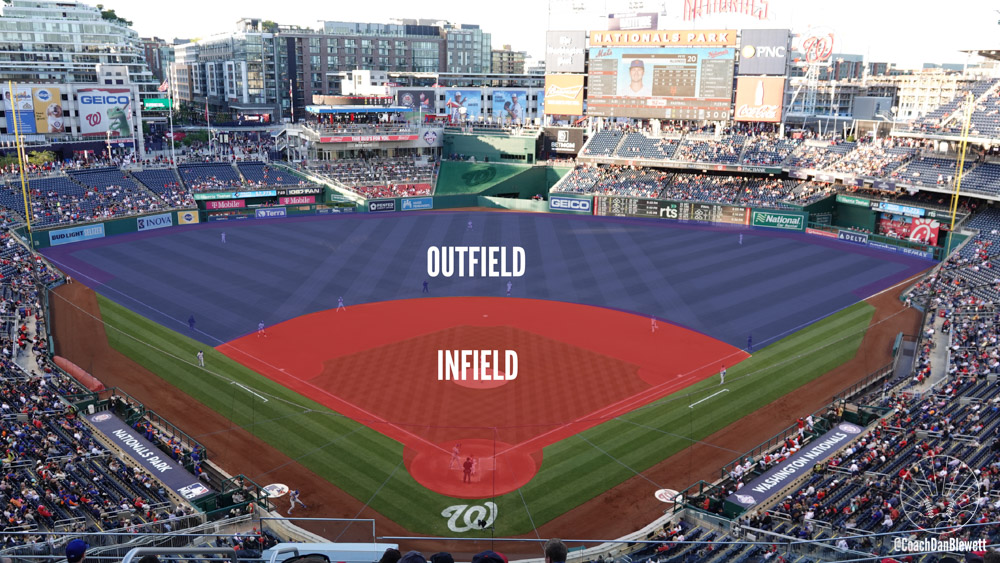
There are three outfielders in the outfield, along with six players on the infield, including the pitcher the catcher first base second baseman shortstop and third baseman. There is also a designated hitter, who hits in place of the pitcher. Rules for designated hitters vary by league.
The Four Bases in Baseball
There are four bases: first base second base third base and home, called “home plate.”

To score a run in baseball, a baserunner has to advance in order from home to first, then to second, then to third, then back to touch home plate. This is one of the fundamental baseball rules.
Watch the video below on baseball positions to learn more about the skills and profiles of each player.
It’s also important to note that home plate and all three bases in the field are entirely in fair territory so if you see a ball hit down the line it hits third base, that ball is fair. If a ball were to stop on home plate after being hit which is pretty unlikely but it does very once in a while happen that ball is fair. Let’s discuss fair vs foul balls in more depth.
Fair and Foul Territory
Fair and foul are two key concepts to learn within the rules of baseball. Fair balls are in play.
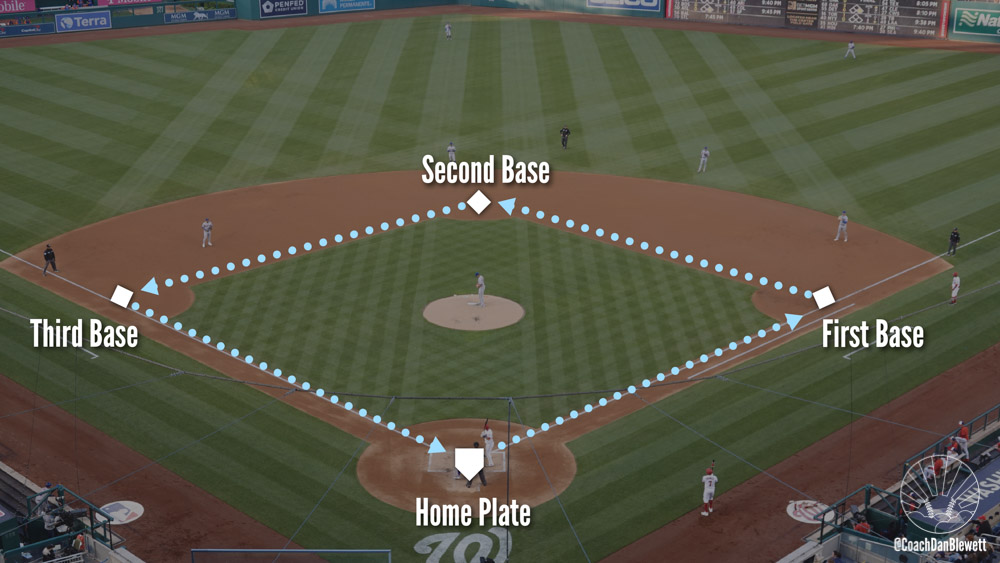
There are two foul lines the first base foul line and the third base foul line.
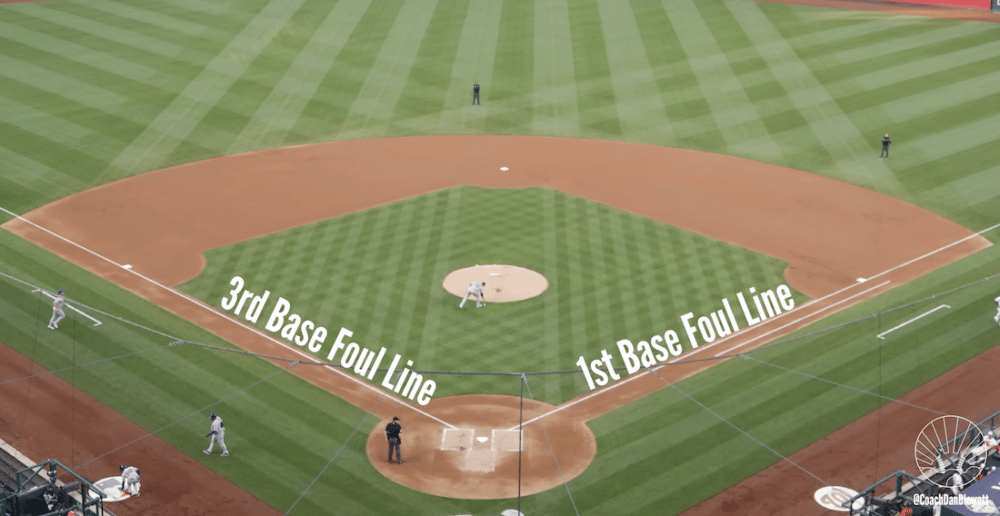
The foul lines separate fair create this fair territory from foul territory. If the ball hits the foul line it is fair so if it touches any part of the line it’s fair and if it hits the yellow foul pole at the home run fence that is a fair ball and would be ruled a home run.
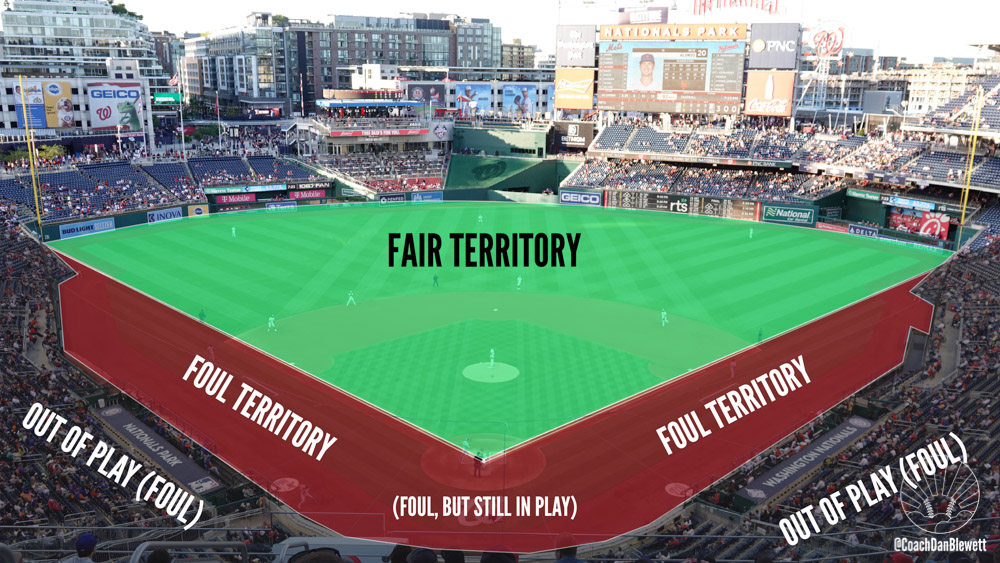
Any ball hit in fair territory requires the batter to run to first base then, to second base then third base then home.
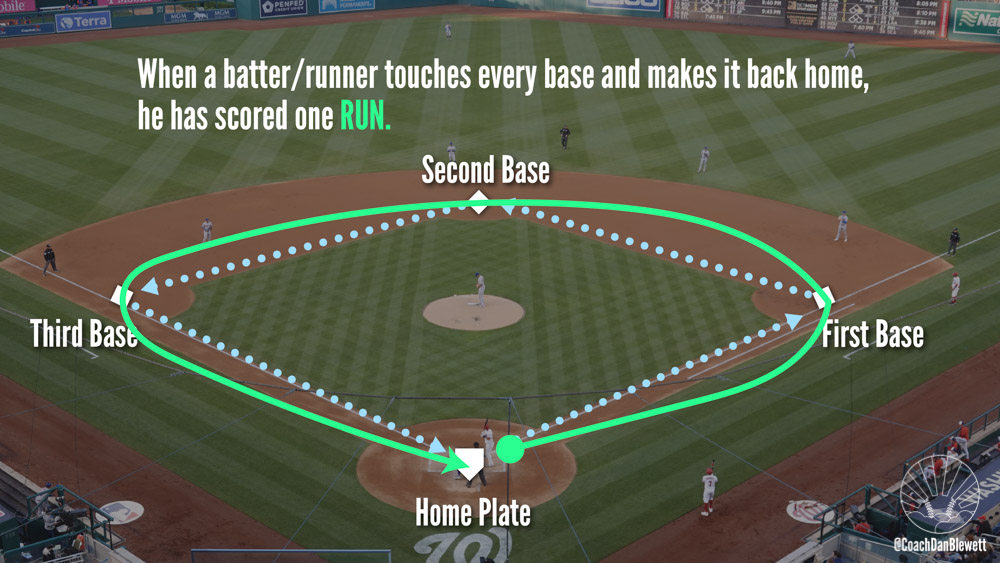
Anything in foul territory, if it’s still in play, can be caught in the air – these batted balls can still become an out. But if it’s hit on the ground in foul territory. There is also territory that we call “out of play,” which is also a foul territory but fielder’s can’t go there. If the ball is thrown into out of play, or if it’s hit out of play, the play is going to be dead.
Next, let’s discuss when a ball is initially in fair territory and then rolls into foul territory. In the infield, the ball can initially be fair and it can just roll off and go foul.
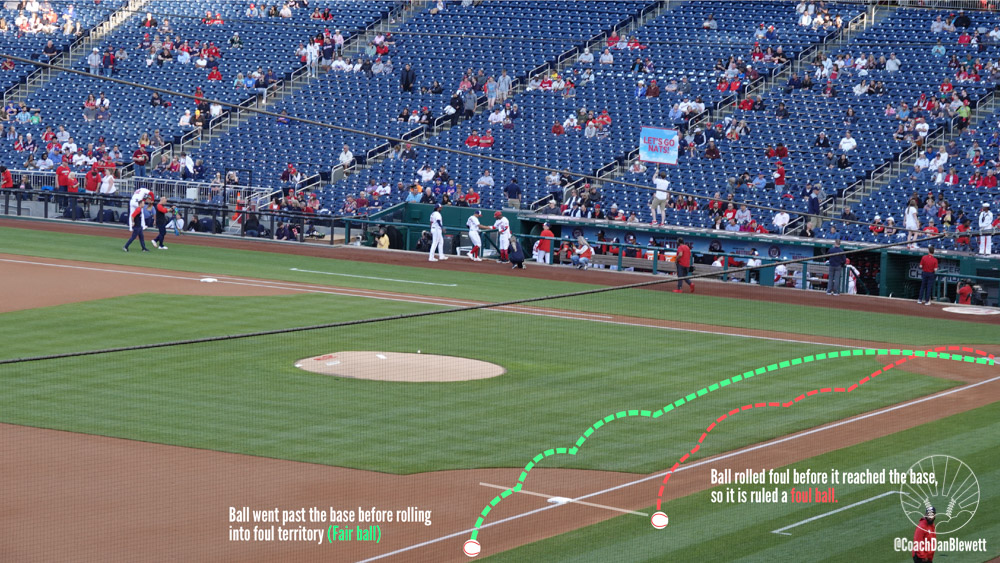
Batted balls have spin especially down the line so this is pretty common and the rule is that the ball has to reach third base or reach first base depending on which line it’s on. A batted ball has to go past third or first before curving foul to be considered still a fair ball, so if you hit a ground ball that’s bouncing in fair territory and it goes past third base and then curves foul that’s still a fair ball.
However, if you hit a ground ball down the third base line and it curves foul before it hits third base then that will be a foul ball so as long as it’s inside fair territory past third base then it will be fair for the rest of the play until the play is dead later.
Teams, Innings and Outs – Essential Baseball Rules
In baseball, there are two teams – a home team and a visiting team, which we also call the away team.

The away team hits in the top half of each inning and the home team hits in the bottom half of each inning. There are nine innings in regulation baseball game, and each of those nine innings are divided into two half-innings. Each half inning contains three outs.
When the team up to bat records three outs, then the two teams switch – the team that was in the field comes in to hit and the team that was hitting goes out to field. In summary, every half inning teams switch so each team will play the field and they will bat for three outs every single inning.
Professional and college teams play nine inning games, a “regulation” game length. High school teams in the US and below all play seven inning games.
Extra Innings
It’s important to note that there’s also extra innings. If teams are tied after regulation so after nine innings or seven innings for amateurs, then they’ll play an additional inning. If teams are still tied then they’ll play another and they’ll keep playing another until one team pulls ahead after a complete inning, at which point the game will be over.
The Objective of a Baseball Game
The objective of a baseball game, the way a team wins, is to get more runs than the other team over the course of the nine inning game.
How to Score Runs
In baseball, a team scores a run by advancing to first base then second base, then third base, then home.
A batter can hit a home run and score a run all by himself. Or, he his team can hit four singles or any combination of hits, walks, errors or hit by pitches to advance.
Recording Outs
How does the fielding team record the three outs, to end the hitting team’s time at bat?
When the batter comes up to the plate to hit, and does not reach base safely, that means he is out. If he reaches base safely then we call him safe so he’s safe. Runners can also be called out while running the base paths, and they must stay in the base paths as defined within the rules of baseball.
Hitting – Key Concepts
Hitting and pitching are where the game starts and stops, so let’s dive in to outs, reaching base safely, then to the hitter vs pitcher dynamic.
Ways Players Can Get “Out”
There are a number of types of ways to get out in baseball:
- Strikeout
- The hitter can strike out which means he did not hit the ball into fair territory during his time at bat that means the pitcher got three strikes on him before he could hit the ball into fair territory.
- Fly out
- When the batter hits the ball in the air, if the fielding team catches it before it touches the ground or any object attached to the ground (like the outfield fence) then the batter is out.
- Ground out
- When the hitter hits the ball, bouncing on the ground, and the fielding team throws it to first before he reaches it.
- Force out
- A force out is when the fielding team throws the ball to the base that a baserunner is “forced” to run to, because all bases behind him are occupied. If the ball beats the runner to that base, it’s a “Force out”.
- Tag Out
- If a runner is off the base (including the hitter running to first) and a fielder touches him with the ball (called tagging), then the runner is out.
Double Plays
A double play can happen multiple ways – a hitter can hit the ball on the ground, and the fielding can complete two force outs on the same play. A double play isn’t so much part of the rules but is a general concept. There are double plays and, occasionally, triple plays.

Or, a ball hit in the air can be caught and a runner can be doubled off his base by not going back in time. Or, any combination of outs can be made – runners can be tagged, forced out, or even a “strike ’em out throw ’em out double” play can happen, which is when a runner is caught stealing on the same pitch that a batter strikes out on.
Line Drive Double Plays
When balls are hit in the infield hit very hard (which we call line drives) they’re often hit so hard and they’re caught so quickly, that runners don’t have time to get back to their original base. Those line drives will often result in a quick double play because the fielding team catches the line drive and quickly throws it behind the runner before he can get back to his base.
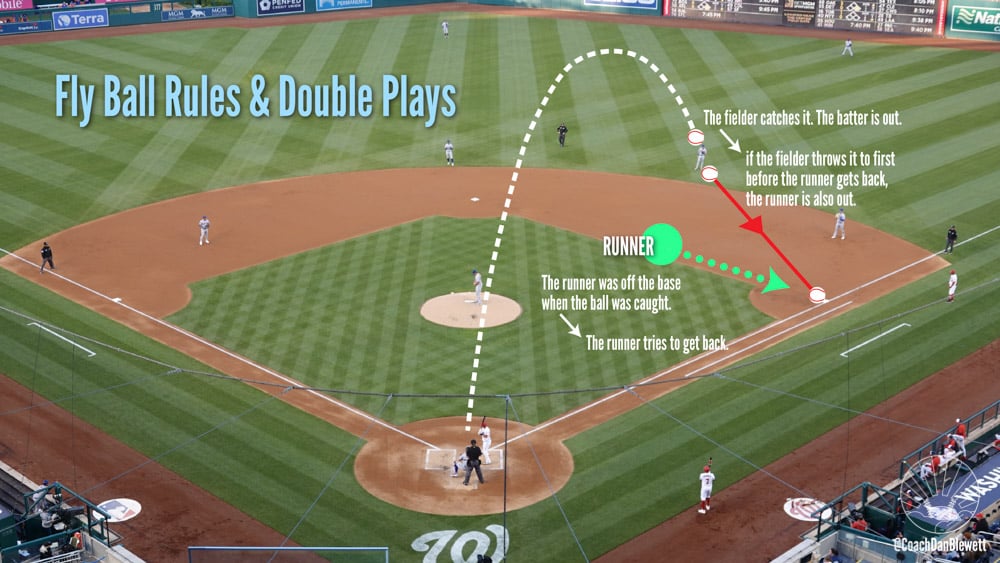
But, the most common double plays are ground ball double plays, when an infield grounder is hit and two force outs are recorded, usually at second base, then at first base.
Tagging Up
The “tag up” rule is also known as “tagging up. This is when the ball is hit in the air. Runners can’t just continue to run as far as they want – they have to go back to the base and retouch before advancing to the next base.
When a baserunner wants to advance on a fly ball (usually from second to third, or third to home) he will wait until the outfielder catches, and will stand on the base. Then, he’ll tag up by running to the next base as the outfielder throws and tries to get him out. Tagging up is a key part of baseball rules that beginners should understand.
The 7 Ways to Reach Base Safely
When a hitter goes up to hit he can also reach base safely a number of ways:
- Base hit
- When a batter hits the ball and reaches base with out any baserunners getting out, or any errors being made
- Walk
- When the pitcher throws four balls during an at-bat
- Hit by a pitch
- When the pitcher hits the batter with a pitch
- Reach on an error
- When the defense misplays the ball badly enough where the hitter reaches first safely
- Reach on a fielder’s choice
- When the batter hits the ball and the fielding team chooses to get a baserunner out, which allows the batter to reach first
- Catcher’s Interference
- If the batter swings and hits the catcher (typically the catcher’s mitt) he is awarded first base
- Dropped third strike
- If the catcher drops the third strike of an at-bat, or it hits the dirt, the runner can run to first base. The catcher can still get him out by tagging him or throwing it to first before the runner gets there. This is one of the less important baseball rules (and in my opinion, should be eliminated).
Types of Base Hits
There are four types of base hits: singles, doubles, triples and home runs. Each corresponds to the number of bases the hitter safely reaches without errors.
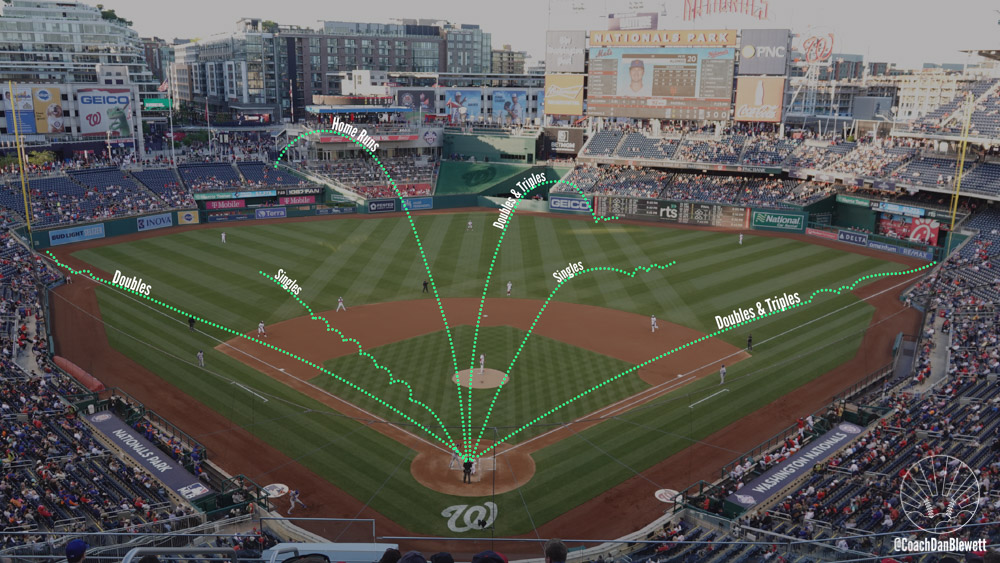
Singles are typically hit just through the infield, they’re blooped over the infield, or they hit a line drive through the infield. But, singles usually don’t go past the outfielders – that’s why they can only get one base.
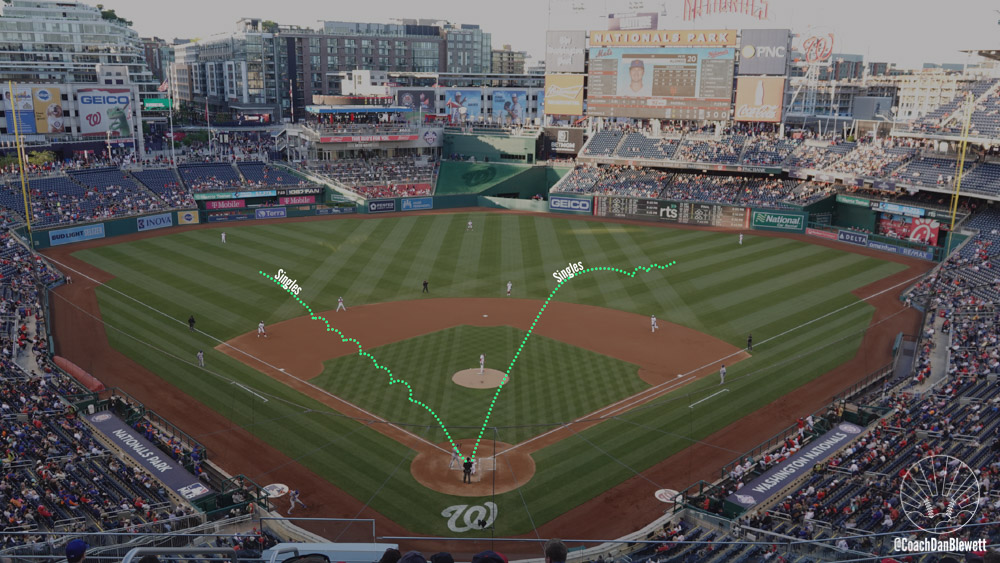
Doubles and triples are typically hit all the way to the outfield wall which gives the runner extra time to run to a second base. Triples are usually only hit to right field. This is because when a ball is hit into the right field corner or into the right field gap, it’s both a long run and a very long throw to third base.

Home runs are hit over the outfield fence in the air, or hit as an “inside the park home run,” which is when the ball stays in play but doesn’t go over the fence. These are rare in pro baseball or on fields where there is an outfield fence in general. Inside the park home runs usually require a weird bounce or an outfielder tripping and falling. They are more common in amateur baseball when there isn’t an outfield fence.

👉 Walks, hit by pitches, base hits, errors and fielder’s choices are by far the most common ways of reaching base safely in baseball.
The “Fielder’s Choice”
This is one of the most common ways players reach base and it’s really important to understand how this ties into the strategy of baseball. The fielder’s choice rule in statistics is crucial to understand.
On a fielder’s choice, this is when the fielding team decides to get a base runner out even when they had the option to get the batter out.
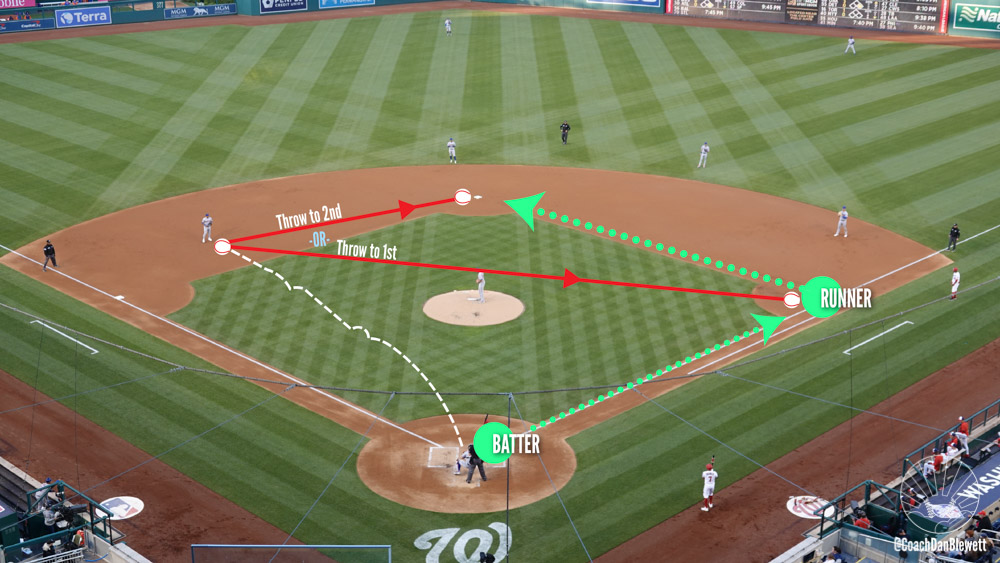
If a fielder only has the time to get one out, it makes sense for them to get the runner out at second base rather than me the hitter at first base in the graphic above. This is called getting the “lead runner” out.
In this example, they’ll throw to second base and get the force out there. This allows the batter to reach first. But because the hitter didn’t get a base hit (the fielding team fielded it), it’s ruled a fielder’s choice and the hitter gets an 0-for-1 for his statistics in the at-bat. These happen all the time when base runners are on base and ground balls are hit, so it’s important to understand this part of the baseball rule book.
Pitching – Key Concepts
At the most basic level, the pitcher throws the ball toward the catcher and the hitter swings his bat and tries to hit it. But, there’s a LOT more to it than that. The first concept to understand is the strike zone.
The Strike Zone
For the game to progress along, the pitcher has to throw the ball toward home plate, where the catcher squats to receive it. The strike zone is an often misunderstood aspect of baseball rules, especially for beginner fans and players new to the game.
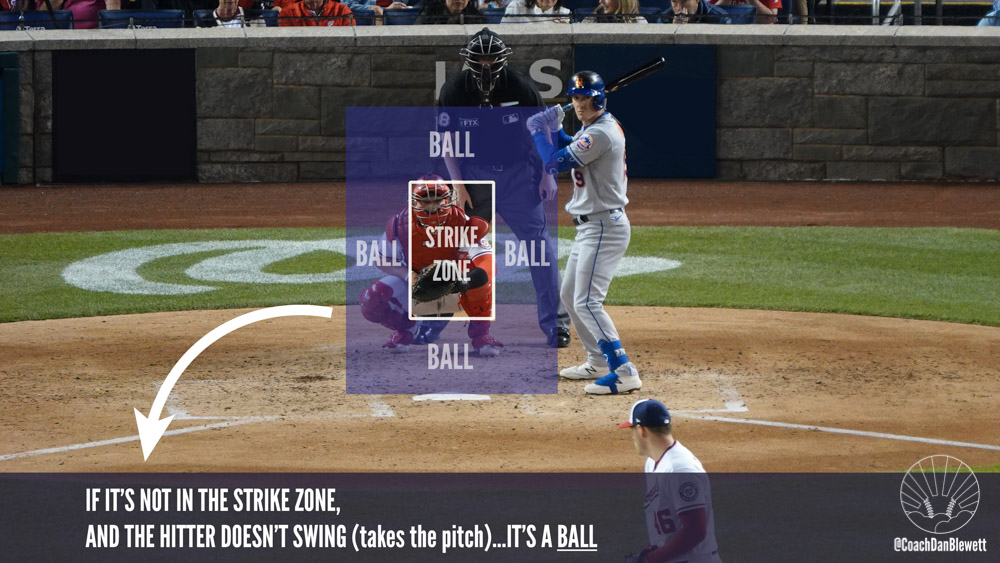
The strike zone goes from the bottom of the kneecap to the letters of the jersey and it extends the 17 inch width of home plate. One thing to consider about the strike zone is that if any part of the ball crosses through it then it’s a strike so because the ball has a width of its own and it could just barely touch the edge the strike zone can actually be as wide as about 23 inches given the width of a regulation baseball on each side of the plate.
Balls and Strikes
The pitcher has to throw the wall into the strike zone to get strikes on the hitter. A pitch that crosses through the strike zone is called a strike, as is any pitch the hitter swings at, whether he misses or fouls the ball off.
Foul balls count as strikes on the first two strikes, but a hitter cannot foul out when he swings – only foul bunts count as a strike out. If a hitter fouls off 5 straight pitches with two strikes, he remains at-bat at and the count stays the same. More on the count in a moment.
Any pitch outside the strike zone that a hitter does not swing at is ruled a ball.
The concepts of balls and strikes is what incentivizes the hitter to swing at pitches and the pitcher to throw the ball into a swingable area for the hitter. This keeps the game moving along.
When the hitter walks up to the plate and takes his turn at bat we call that an at-bat. In a typical game of nine innings a hitter will get on average about four at bats. If the game goes longer – the team gets a lot of hits or they go into extra innings – a hitter might get five six seven of bats.
Strikeouts and Walks
Strikeouts and walks are two of the outcomes that can come from balls and strikes.
If the pitcher gets three strikes on the hitter it’s a strikeout, and the batter is out, and the next batter would come up to hit.
If the pitcher throws four balls in the at-bat before the hitter puts the ball in play, or gets three strikes, then that’s called a walk; the hitter is awarded first base.
Swinging vs Not Swinging
Let’s talk about balls and strikes and swinging versus not swinging so the hitter has the option to never take the bat off his shoulder if he doesn’t want to. The hitter doesn’t ever have to swing, and they have full discretion of what they swing. But, hitting the ball is the fun part of baseball.
So hitters want to swing the bat and pitchers need to throw strikes because they want to avoid walking too many hitters. If a pitcher walks a lot of hitters, it’s really hard to win games because there are too many base runners on base. Lots of baserunners means only a couple of hits will bring across a bunch of runs.
The best pitchers in the world they both give up very few hits and they also walk very few batters.
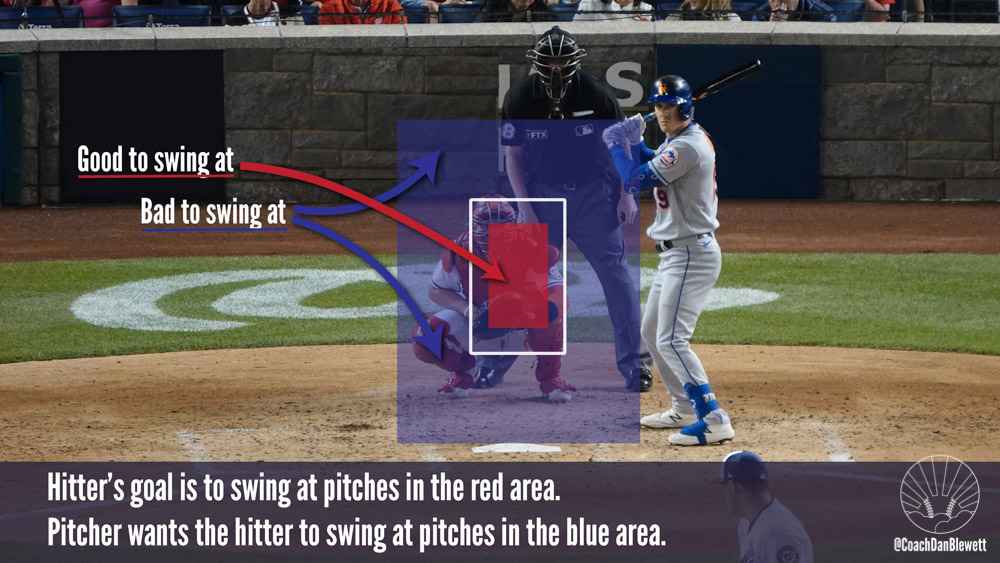
The strike zone is not huge, but it is big enough where unless the pitcher throws it into the center portion of the plate it’s pretty hard for the hitter to square the ball up and hit it hard. The pitcher is essentially trying to throw the ball into the strike zone, but towards the peripheral edges of the strike zone.
This makes it harder for the hitter to hit the ball hard, even though the pitcher is throwing strikes.
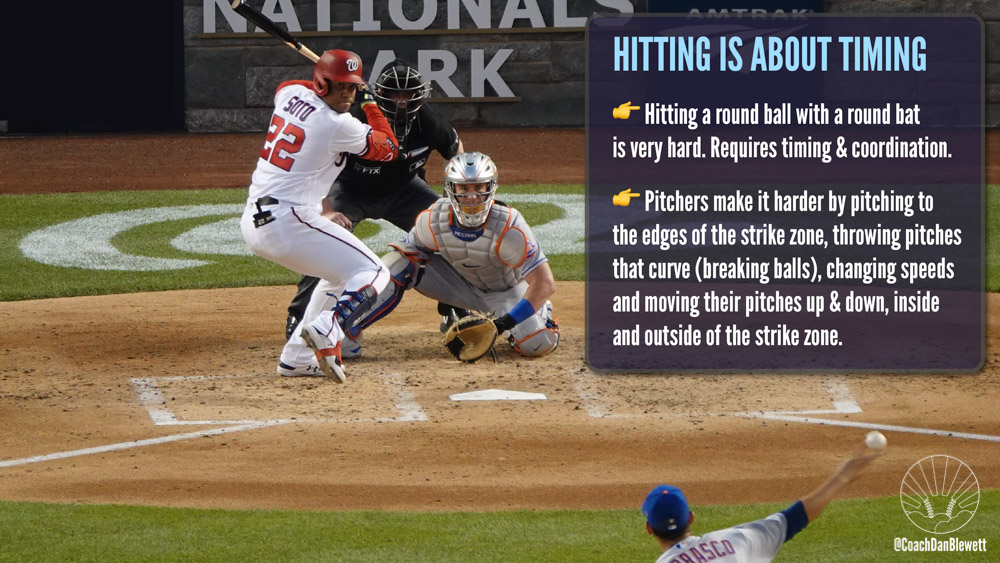
The best hitters are very good at laying off pitches that are outside the strike zone, which we call balls, and from laying off pitches that are in the strike zone but not easy for them to hit hard. The best hitters are very disciplined at swinging on only pitches that they can hit hard a higher percentage of the time.
The Count
The count is just a way of keeping track of the balls and strikes in an at-bat. Balls are listed first, strikes are listed second.
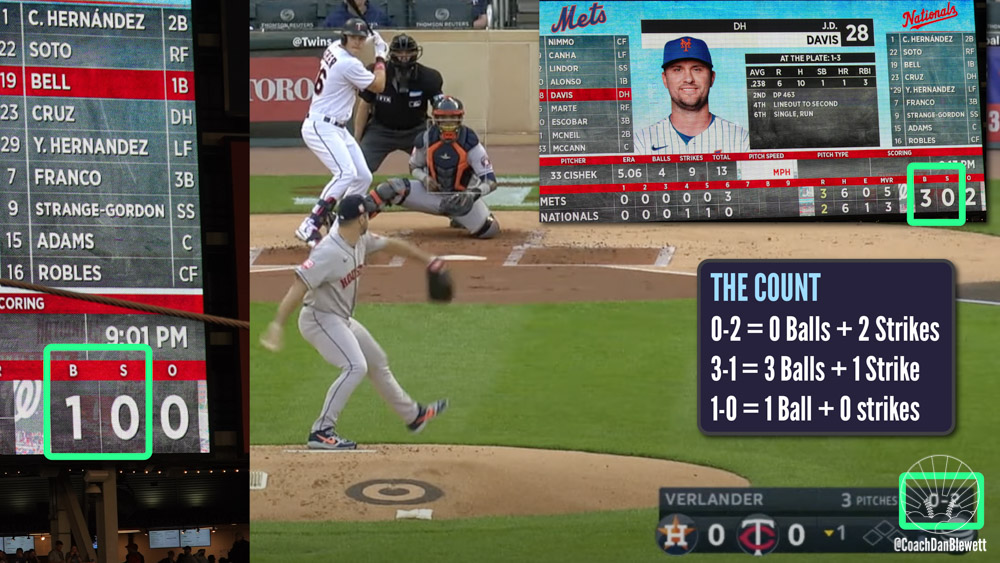
The count is easy to understand: 3-1 = three balls and one strike. 2-2 = two balls and two strikes. And so on. Beginners overlook the count from a strategy standpoint.
👉The count is one of the most important aspects of the strategy side of baseball.
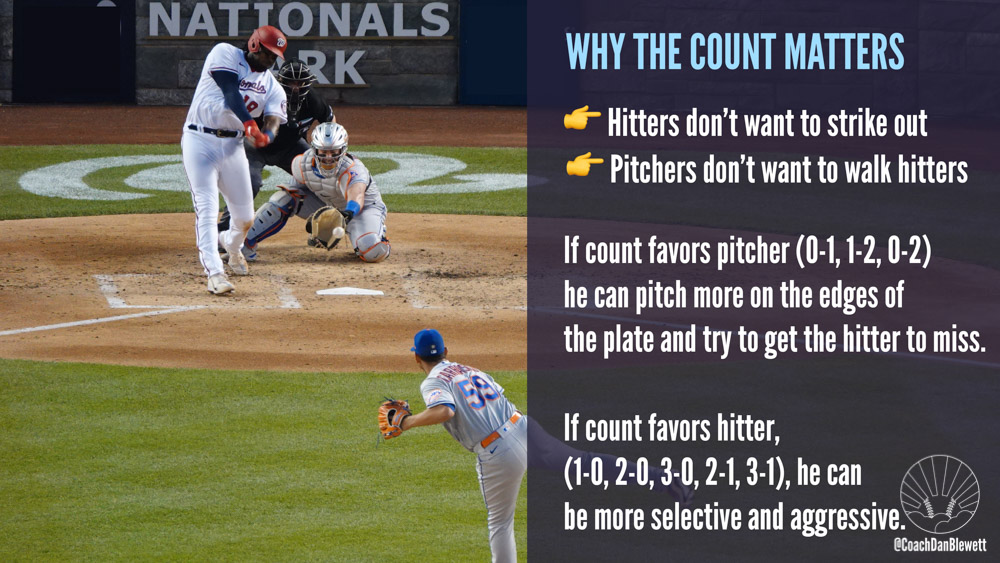
The count is absolutely critical to what’s going on between the hitter and the pitcher because if the hitter is ahead in the count, the hitter is in no risk of striking out.
Essentially, he’s got a bunch of pitches before it might even be close that he might strike out. So the hitter, then, can swing more at pitches that are better for him – he can be more selective and not swing at stuff that’s on the edge of the strike zone or outside of the strike zone. This makes it more likely for a hitter to get a good hit especially a hard hit when the count is in his favor.

Now if a hitter falls behind in the count – say the pitcher gets two strikes on him with no balls – the hitter is kind of desperate and is afraid he might strike out. So, the hitter is going to start to swing at an expanded part of the strike zone because he doesn’t want the umpire to call him out on strikes. He can’t take borderline pitches anymore.
When the pitcher is ahead they have the power because now if a pitcher has no balls and two strikes he can throw curveballs and sliders and fastballs outside of the zone and try to get the hitter to swing at something that’s not good for him to swing at, something that he can’t hit very hard or something that starts as a strike and then breaks outside the strike zone. This is why the dynamic of the count is so important – it changes as the bat progresses. It’s a constant fluctuating power dynamic, and the count is a really huge part of the game.
Pitchers who get ahead in the count are much better than pitchers who don’t typically, because when a pitcher is ahead in the count consistently, he can throw more of what’s bad for the hitter. The count is a huge concept to understand and you continue to learn the rules of baseball.
The Infield Fly Rule
The infield fly rule is one of the most confusing baseball rules for new players, though it’s not really that complicated. Learn about it in my video below.
The infield fly rule is called when there are runners on 1st and 2nd base or the bases loaded, with less than two outs. It’s important in keeping the game fair and interesting.
Learn more about this rule in my article about the infield fly rule here.
Balks in Baseball – A Pitching Rule
Balk rules are also confusing for new players, and there are a lot of criteria for what is, and is not, a balk.
Learn To Play Baseball
If you’re new to baseball and want to learn some of the fundamental skills, start with my how to throw a baseball video below.
Free Baseball Rules & Lingo Cheat Sheet
Below you’ll find my free baseball watching guide. It’s a cheat sheet that if you can print out, with different terminology and baseball lingo. Download the free baseball lingo cheat sheet here.
